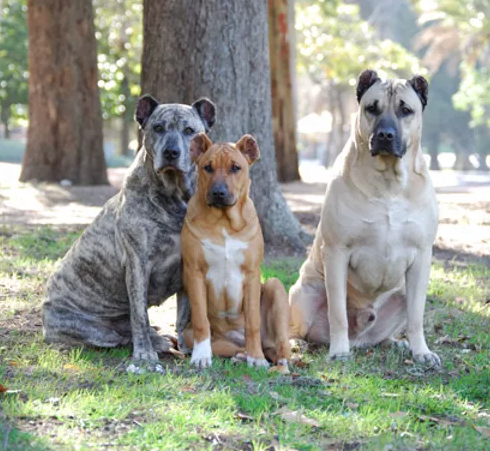The Cimarron Uruguayo is thought to be descended from dogs brought over to Uruguay by Spanish and Portuguese conquerors (possibly the Alano Espanol and similar breeds), which were later abandoned in huge numbers. These semi-feral dogs bred amongst themselves with only the strongest surviving. At first these wild dogs were considered a nuisance and a danger to livestock and people – and bounties were even offered up to those who would kill the dogs. Eventually, realizing that the dogs could actually be useful, ranchers would capture and re-domesticate them. The dogs were found to be fantastic guard dogs and could also be used to hunt large game as well as herding. Today, the breed is actually the mascot of the National Army of Uruguay! This molosser breed is rare in the United States (although recognized by the UKC), but is very familiar overseas and recognized by the FCI.
Cimarrons are incredibly brave dogs – a trait that is even noted in the standard. This said, they have a steadfast and calm temperament and when bred/raised correctly are very dependable. They are very loyal to their families and get along with children without issue as long as they had been socialized when young. They are, however, suspicious of strangers – never forget that this is a serious guard dog that will do his job if he feels it is necessary! Cimarrons are not for first-time dog owners and can be aggressive in the wrong hands. Furthermore, many of them are also not dependable around other dogs and can be dog-aggressive, regardless of how they were raised.
The Uruguayo is intelligent and trainable. This said, it takes an experienced person to work with this dominant breed! The better they are raised as a puppy, the easier training will go however most are stubborn, determined and domineering as a rule. Owners that don’t care about rules at all may end up with an aggressive and overbearing adult, so let us be clear… training and rules are 100% necessary for this breed! Be prepared to be very firm when setting down and enforcing rules. Novices should look elsewhere! Furthermore, the Cimarron requires mental exercise and does need a job to do in order to be happy and fulfilled. Obedience training can be used for a job in itself, and it can also be used to form the building blocks for learning other more specialized jobs!
The Cimarron Uruguayo isn’t apt to bark unless something is amiss, which makes him a fairly quiet companion most of the time. He can be kept in an apartment under the right circumstances, and as long as he is given plenty of exercise. Being high energy, he needs a fair amount of time to run each day. This is much more easily accomplished with a home on a large fenced property but a dedicated person in a smaller living environment can make it work if they spend lots and lots of time exercising the dog (this means 2 hours a day minimum). Take note that if he lives outside all day (not recommended) he will likely end up guarding the yard and could end up becoming a liability in the wrong circumstances. Just as he is not recommended for apartment living if the owner cannot exercise enough, he is also not recommended for owners who just want a dog to roam the property/yard unsupervised all day.
The coat of the Cimarron is short and smooth, with presence of an undercoat. A long coat is a disqualification. Most often they are seen in brindle although they can also come in any shade of fawn. Dogs are also allowed to either have a black mask and/or black shading, although it is not required. Some members of the breed have splashes of white, although any white must remain only on certain parts of the dog. Size-wise, these molossers aren’t particularly tall (small females can be around the 21 inch mark while a large male won’t top 24 inches) but in terms of mass they can be extremely large – as heavy as 100 pounds! One of the distinguishing features are the ears, which are often traditionally cropped in the shape of a puma’s ears – rounded all over. The crop is said to be done in homage to the dogs which were originally killed for bounty, in which bringing an ear would prove the dog had been slain.

Photo by Coquimbo58
